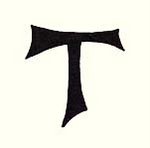





The Romans were never far from us. Assisi had been an Imperial City. It had a circus and a forum. I spent time below the piazza del commune looking at artifacts of that forum. The city had a Roman brothel. When we were in Assisi the frescoes advertising that business endeavor were temporarily covered up to protect them from on-going construction. The city had a Roman Temple. It was named the Temple of Minerva. Minerva was the Goddess of Wisdom and Peace. She was a healer and indeed this temple had a long history of healing. Before its dedication to Minerva it was associated with the healing powers of Castor and Pollux. Their sister was Helen of Troy and their father was Zeus, not too shabby a family tree. Today the temple is very different. Outside one sees the Corinthian columns and can imagine togas and sandals. Inside is the “Church of Saint Mary Above Minerva”.
The city was originally Etruscan. Then in 295 BCE, Assisi became part of the comune of Rome. In 88 BCE, the city became a "Municipium romanum" (Roman municipality), with all the rights and regulations afforded to Rome. During the reign of the emperor Augustus, the city of Assisi was transformed into a well organized residential center (28-25 BCE). A grand Forum was constructed that included temples, the city walls, the baths and the (healing) springs of mineral waters, and a theatre and amphitheatre. Assisi was indeed a Roman Imperial City.
During the period in which Christianity was viewed as a threat to the Empire the temple was the site of numerous tribunal trials ending in martyrdom for the Christians of the region. When Christianity became the religion of the Empire the temple stood abandoned for over a century. In the second half of the sixth century, the Benedictine monks restored the temple. With the act of May 24, 1212, for one hundred years, with the option of renewal, the Benedictines leased the temple to the Comune of Assisi. The temple has had many reincarnations since then but it continues to stand as a monument to Ancient Rome.
We saw Roman walls being uncovered as workers repaired a road in Assisi. We saw the home of the poet Sextus Properitus (50-15 BCE) located in the ground floor of Santa Maria Maggiore. He was friends with Horace, Virgil and Ovid.
While in Assisi I drank out of a Roman fountain. On our trips we saw Roman Aqueduct. And now finally Rome!
Ron, Lil, Peter and I walked around the Forum. It was enormous and went on for blocks. We saw temples, homes and business centers. The Forum was the political center of Rome during the Republic. There was another temple to Castor and Pollux, one to Saturn, and other lesser temples. The residence of kings was there. We walked and walked and the monuments, digs, foundations to homes continued.
We made it to the Coliseum. It was constructed in 72 CE. It had hidden passages, movable stages, cages and plumbing. Today it stands as a monument to one of the worlds greatest empires. At one time it could hold up to 55,000 spectators. I am stunned by its magnificence.
Finally we walk over to the Pantheon. Originally it held statues of the Roman Gods. After the Empire embraced Christianity it housed statues of the saints. Outside it is stark and stained by auto fumes. Inside it is a temple that houses saints, the sun shines through the dome and one can still easily imagine the Romans, in togas coming to commune with their gods.
The city was full of temples, tombs of Emperors and ancient inscriptions. Still, for me, my favorite site was the tomb of a simple fisherman from Galilee.
I loved our Franciscan Pilgrimage, I loved our Catholic Pilgrimage. However, it was the evidence found everywhere of these ancient pagan people that demanded my attention. I look forward to one day spending more time with the Romans.













No comments:
Post a Comment